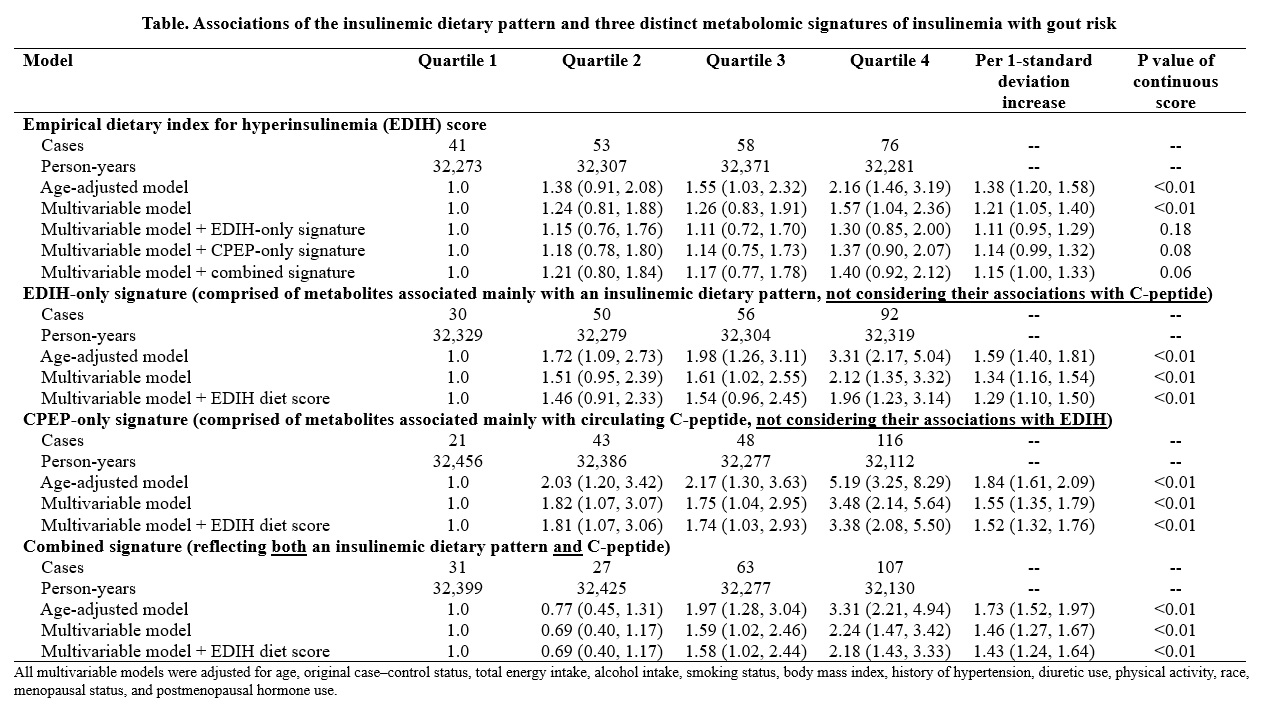Session Information
Date: Sunday, November 17, 2024
Title: Metabolic & Crystal Arthropathies – Basic & Clinical Science Poster II
Session Type: Poster Session B
Session Time: 10:30AM-12:30PM
Background/Purpose: Gout and the metabolic syndrome frequently coexist. Intravenous insulin has been shown to raise serum urate levels in physiologic studies, and a Mendelian Randomization study showed a causal role of fasting insulin on the risk of hyperuricemia and gout.1 Moreover, a hyperinsulinemic diet has been associated with a nearly two-fold higher gout risk,2 although the underlying mechanisms linking this diet with gout are not fully clear. Large-scale analyses of metabolites may be useful to evaluate metabolic responses to diet. We prospectively examined the associations of 3 distinct metabolomic signatures of insulinemic diet and plasma C-peptide with incident gout risk among US women, a key understudied subgroup with an increased comorbidity burden.
Methods: We analyzed data from 5,936 women from the Nurses’ Health Study with metabolite data who were free of gout at baseline. Diet, covariate data, and new cases of physician-diagnosed gout were collected by validated questionnaires every 2-4 years. We calculated an empirical dietary index for hyperinsulinemia (EDIH)3 for each woman, with higher scores indicating a higher insulinemic tendency. To evaluate the interplay between the EDIH, plasma metabolome, and gout, we examined 3 distinct metabolomic signatures constructed using elastic net regression.4 These 3 signatures included metabolites that were predominantly associated with: (1) the EDIH dietary score, regardless of the metabolites’ association with C-peptide (i.e., EDIH-only signature); (2) C-peptide (insulin resistance marker), regardless of the metabolites’ association with diet (i.e., CPEP-only signature); and (3) a combination of both the EDIH and C-peptide (i.e., combined signature). We used multivariable Cox models to evaluate the associations between each metabolomic signature and incident gout.
Results: We ascertained 228 cases of incident gout over 26 years. In our multivariable-adjusted models (including BMI adjustment), women in the highest EDIH quartile had 1.57-times (95% CI 1.04, 2.36) greater gout risk, compared with the lowest quartile (Table). We observed strong positive associations with gout risk for the EDIH-only (HR for extreme quartiles 2.12; 95% CI 1.35, 3.32) as well as the CPEP-only (3.48 [2.14, 5.64]) metabolomic signatures. Greater scores for the combined signature were also associated with higher gout risk (2.24 [1.47, 3.42]). The association between the EDIH (diet) and gout was attenuated after adjusting for any metabolomic signature (HR for extreme quartiles 1.30 [0.85, 2.00], 1.37 [0.90, 2.07], and 1.40 [0.92, 2.12] after adjusting for the EDIH-only, CPEP-only, or combined signatures, respectively), suggesting that these metabolomic profiles are highly reflective of dietary insulinemic intake.
Conclusion: These novel metabolomic signatures of an insulinemic diet were each strongly associated with gout risk, providing further support for this extrinsic, modifiable driver of insulin resistance in gout risk, and as a potential target for intervention.
References:
1. McCormick et al. A&R 2021 [PMID: 33982892].
2. McCormick et al. A&R 2021 [abstract].
3. Lee et al. Diabetes Care 2020 [PMID: 32873589].
4. Lee et al. Diabetologia 2024 [PMID: 37816982].
To cite this abstract in AMA style:
Rai S, Choi H, Yokose C, McCormick N. Distinct Metabolomic Signatures of Insulinemia and Incident Gout Risk: A Prospective Cohort Study Among Women [abstract]. Arthritis Rheumatol. 2024; 76 (suppl 9). https://acrabstracts.org/abstract/distinct-metabolomic-signatures-of-insulinemia-and-incident-gout-risk-a-prospective-cohort-study-among-women/. Accessed .« Back to ACR Convergence 2024
ACR Meeting Abstracts - https://acrabstracts.org/abstract/distinct-metabolomic-signatures-of-insulinemia-and-incident-gout-risk-a-prospective-cohort-study-among-women/

